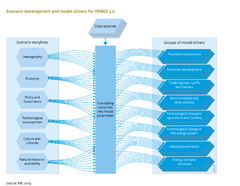Drivers: Difference between revisions
Jump to navigation
Jump to search
No edit summary |
No edit summary |
||
| Line 2: | Line 2: | ||
|Status=On hold | |Status=On hold | ||
|Application=Millennium Ecosystem Assessment; OECD Environmental Outlook to 2050 (2012); IPCC SRES (2000) | |Application=Millennium Ecosystem Assessment; OECD Environmental Outlook to 2050 (2012); IPCC SRES (2000) | ||
|ExternalModel=ENV-Growth model | |ExternalModel=ENV-Growth model; MAGNET model; | ||
|KeyReference=IPCC, 2000; OECD, 2012; MA, 2005; | |KeyReference=IPCC, 2000; OECD, 2012; MA, 2005; | ||
|Description=In order for the IMAGE model to explore future scenarios, exogenous assumptions need to be made for a range of factors that shape the direction and rate of change in key model variables and results. Together with the endogenous functional relationships and endogenous model parameters that jointly typify the behaviour of the model, these exogenous assumptions drive the outcome of any particular model calculation. In other words, these assumptions are the drivers that determine the model results subject to the assumed external conditions. | |Description=In order for the IMAGE model to explore future scenarios, exogenous assumptions need to be made for a range of factors that shape the direction and rate of change in key model variables and results. Together with the endogenous functional relationships and endogenous model parameters that jointly typify the behaviour of the model, these exogenous assumptions drive the outcome of any particular model calculation. In other words, these assumptions are the drivers that determine the model results subject to the assumed external conditions. | ||
Revision as of 13:11, 11 December 2013
| Projects/Applications |
| Models/Databases |
| Relevant overviews |
| Key publications |
